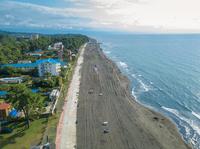Atsana (აცანა) is a village in Guria, Georgia, within the Lanchkhuti municipality and the center of its community, which also includes Telmani. It lies on the southern slopes of the Gurian Ridge, by the Atsauri River, at about 150 m (≈ 492 ft) above sea level and 8 km (≈ 5 mi) from Lanchkhuti. The Lanchkhuti–Nasakirali road passes through the village. Atsana has a school, kindergarten, library, medical post, and cultural center.
The name Atsana likely comes from a Laz-Chan root, and the village is known since antiquity. Among its oldest relics is a lifting stone once used for contests. In the past, silk production flourished, and noble families like the Tuski lived here. From the 17th century it belonged to the Tavadgiri family. A week-long market was held each autumn in the 1850s, a one-room school opened in 1883, and after the suppression of the Gurian Republic in 1906, the village was burned by troops. Under Soviet rule, Atsana became a tea-growing center with a local factory; corn, tung, and citrus were also cultivated.
Atsana combines history and nature, inviting travelers who want to discover Georgia beyond the usual routes. Once there stood the Oqoni Monastery with its fortification wall, abandoned in the 19th century and later replaced by a new church. The village also had a 19th-century wooden domed church of the Savior, now lost, and remnants of St. George’s church still remain. On the road to Mamati, a right tributary of the Atsauri hides the Sakukhia Waterfall, while the nearby Sakukhia Canyon stretches about 16 km (≈ 10 mi), offering scenic ravines and forested slopes.
Over time, the population changed from 1,775 in 1914 to 586 in 2014. Notable natives include politician and diplomat Grigol Uratadze, actor Vasil Chkhaidze (1905–1986), and Hero of the Soviet Union Davit Tavtadze (1916–1979).





 Ureki
Ureki
 Ozurgeti
Ozurgeti
 Nagomari
Nagomari
 Gomismta
Gomismta